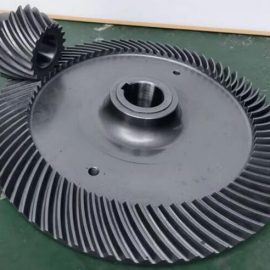QT40-10 Ductile Iron Heat Treatment Process
Since the graphite contained in ductile iron is spherical, and its mechanical properties can be improved by heat treatment, and the nodularizing agent required for the production of ductile iron, rare earth magnesium alloy, is abundant in my country, so ductile iron is widely used in agricultural machinery production. middle. At present, the highest strength ductile iron is QT40-10, which is mostly used in the manufacture of crankshafts, camshafts, gears and other parts. The lowest strength but the best toughness is QT40-10, which is used in most of the cast iron castings in agricultural machinery production.
Selection of heat treatment process parameters:
1. Heating speed
The annealing operation is generally a cold furnace charging, and the temperature rises after the furnace door is closed. Due to the large internal stress and poor thermal conductivity of ductile iron, the heating speed should not be too fast, but in order to improve production efficiency, the production cycle should be shortened as much as possible. . According to our practice, before heating to 600℃, the speed of 100-150℃/hour can be controlled, and no deformation occurs.
2. Insulation temperature
Whether it is high temperature or low temperature insulation stage, there is a maximum heating temperature range. Our experience is that the upper limit temperature insulation is used to make the graphitization process slow.
3. Holding time
The length of the holding time should take into account whether the inner and lower parts of the workpiece are burned through. According to the heat preservation time introduced by the relevant information, the effect is not good. Better results can be obtained by increasing the holding time to 1 times or even longer. This shows that the holding time described in the relevant information is under ideal conditions, and our specific conditions are far from ideal conditions. Such as the size of the box diameter, the quality of the furnace insulation performance and whether the selection of the temperature measurement point is representative and other factors should be carefully considered, so the insulation time should generally be appropriately increased.
4. Cooling time
In order to avoid generating new stress, the cooling rate should not be too fast. Our actual experience is not to exceed 80℃/hour, which is also higher than the general information.
5. Out of the furnace temperature
We did not find brittleness through the test, slow cooling to below 200 ℃, or cooling to below 600 ℃ and quick cooling. Therefore, it is generally cooled to 600 ° C and released.
QPQ Salt Bath Liquid Nitriding Process Characteristics And Application Heat Treatment Process Control Of Magnetic Properties Of FeCuNbSiB Nanocrystals Effect of Annealing Process on Structure, Magnetic Properties and Brittleness of Fe81Si4B12Cu1P2 Amorphous Alloy Ribbons


Contact us
Your email address will not be published. Required fields are marked *